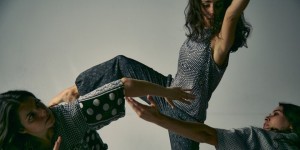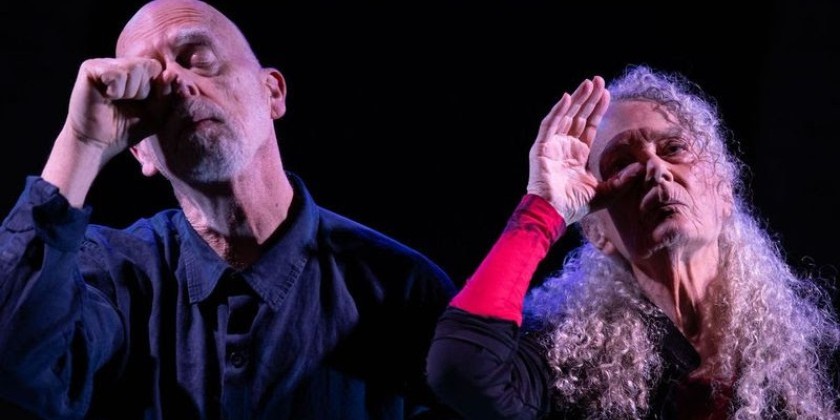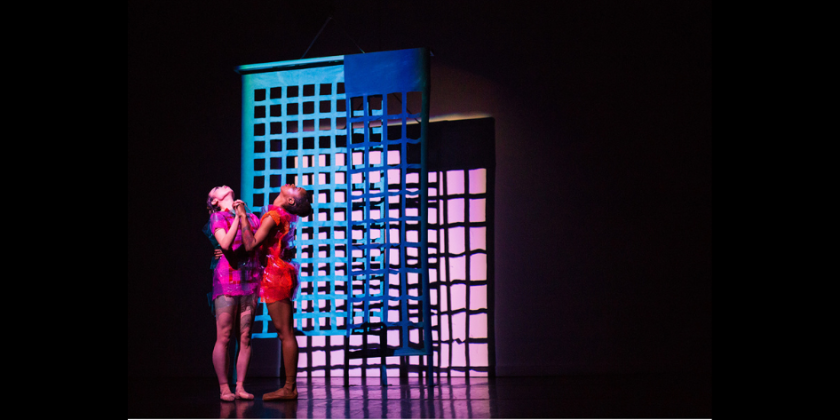IMPRESSIONS: ARTS ALIVE at Arts On Site, Featuring Peter Farrow’s “Nearly” and Annie Rigney’s “Galithea”

February 28th, 2021
Choreography: Peter Farrow and Annie Rigney
Performers: Peter Farrow, Georgia Usborne, Jason Reese Cianciulli
Music: “Nearly”: Frederic Chopin, Gorillaz, “Galithea,”: Kailmankou Denkou (the evening gathering) by Bulgarian State Television Female Choir, Cut the Rug: Move the Earth by The Silk Road Ensemble
As we edge toward the one-year Covid-19 mile marker, Arts On Site adventures into safely showcasing live dance indoors. The women-led nonprofit has taken over all three floors of 12 St. Marks Place, a space once beloved as a popular, donation-based yoga studio. It has filled that building with creative endeavors at a time when opportunities to witness, choreograph, and rehearse live dance are scarce. The aptly titled “ARTS ALIVE” features a collection of NYC-based artists showcasing approximately 45 minutes of work, with two back-to-back shows in an evening. Annie Rigney and Peter Farrow’s shared bill reminds us why viewing live dance is an irreplicable experience.
The evening opens with Nearly, a self-choreographed solo by Peter Farrow, his lone figure a stark shadow against the spacious studio’s brick wall. Hand gestures tie the work together thematically, which range from pedestrian, like talking on the phone or drinking from a glass, to abstract, like in a chain of releasing and catching actions, as though pursuing something slippery and weightless. Sometimes, a small gesture grows and expands through Farrow’s entire body, reverberating into larger movements and sequences. Some harken to previous uses, like elbows folded in front of his face, a yogic eagle pose, or a foot placed in the crease of the opposite hip—tree pose.

These small gestures lead Farrow through space, his movements disregarding gravity. He extends his torso and limbs parallel to the floor as though no hierarchy exists in the available space; open air is as desired as solid ground. In a gorgeous moment, he tips forward suspensefully, one leg curled behind him in a balletic attitude. As Frédéric Chopin bleeds into the funkier Gorillaz, the contrast of Farrow’s movements intensifies until, almost unexpectedly, the lights dim and he exits.
In Galithea, choreographer Annie Rigney explores the ecological phenomenon known as “Edge Effect,” where two distinct environments like tundra and forest intersect to create a dynamic shared space. This concept is reflected both in movement and in music, which is composed by David Bruce as part of Yo-Yo Ma’s Silkroad. The Silk Road Ensemble’s Cristina Pato plays the Galician Bagpipes, a haunting musical manifestation where Celtic and Spanish traditions collide.

Galithea begins as a solo. In silence, Georgia Usborne passes through the audience, her gestures conveying a sense of struggle: a hand cradling her head, an elbow in front of her face, a ducking for cover. Then, she walks directly toward the audience, flinging her limbs into space, before exiting with a stumbling, bourrée-like walk, soon to be replaced by a new figure.
Jason Cianciulli is buoyant and spider-like, swiping his limbs across the floor as though they were the tendrils of a mop. Usborne re-enters, and the two find points of intersection between their bodies, like an elbow in the crook of a neck or an arm extended alongside a leg. They appear to be driven by the same invisible impulses — a wave, a gust of wind — but their responses manifest their unique movement languages. The space between them stretches and contracts, but rarely do they separate.
Cianciulli moves deliberately, tossing Usborne’s limbs, torso, and spine in the direction of his choosing, then assisting during the follow-through by coaxing her out of contorted backbends and distorted shapes. When they separate, they rediscover the independence of their limbs.

Throughout, the dancers seek intersection, a point of commonality. Usborne balances on her upper back, feet pressed into Cianciulli’s chest before he raises himself from his knees to his toes as they struggle to find a counterbalance. Sometimes one energy dominates, like when Usborne nudges Cianciulli’s chest with her head, urging him across the space. At times they appear to need one another, like in a climactic moment where she presses her hands against his hips as he levitates and twirls her around the room.
They roll together across the floor, and Usborne finds an awkward point of stillness, propped on one elbow with a hand against her face, the other tented with splayed-fingers, halfway between a paw and a claw. Cianciulli wraps around her, attempting to fill her negative spaces, then slowly departs, as if leaving behind a hollow shell.
This series was for many the first live show in months, and it conjured up all the things about a live performance that can’t be replicated: the sound of footprints, the breeze cast by a moving body, the reverberation of the wooden floors, the sensation of applauding with other human beings. Artists have persisted in their creative efforts, and as the city inches toward reopening, those quarantined, surreptitious explorations will begin to delightfully reveal themselves to a thirsty public.














